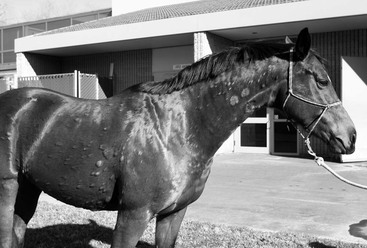Stephen D. White
Atopy
Atopic dermatitis may be defined as an abnormal immunologic response to environmental allergens, such as pollens, barn dust, and molds. It is increasingly being recognized as a cause of pruritus in horses. The disease may be seasonal or nonseasonal, depending on the allergen or allergens involved. Age, breed, and sex predilections have not been extensively reported. A familial predisposition may be present.
The presumed etiology is a type I (immediate) hypersensitivity response, mediated by immunoglobulin E (IgE). Evidence indicates that atopic horses produce allergen-specific IgE. When that allergen is bound to two or more IgE antibodies on the surface of a mast cell, the mast cell releases granules containing various substances that cause erythema, vascular leaking, and pruritus.
Clinical Signs
Pruritus, often affecting the face, distal parts of the limbs, or trunk, is the most common clinical sign. Alopecia, erythema, urticaria, and papules may all be present. Urticarial lesions may be severe but nonpruritic (Figure 129-1). In a study from the School of Veterinary Medicine, University of California, Davis of 54 horses with atopic dermatitis, 28 horses had urticaria, 8 had pruritus, and 18 had both. Horses may have a secondary pyoderma, typified by excessive scaling, small epidermal collarettes, or encrusted papules (“miliary dermatitis”).

Diagnosis
Diagnosis is based on clinical signs and exclusion of other pruritic skin disease, especially insect bite (i.e., Culicoides spp) hypersensitivity. Should the owners elect to treat with allergen-specific immunotherapy (“hyposensitization”), the allergens chosen are based on the results of either intradermal testing (IDT) or serum allergy tests. The IDT involves a series of intradermal injections of aqueous allergen extracts along with a positive (histamine) and negative (saline) control. The injections are usually performed over the lateral cervical or thoracic region. The injection sites are observed for 30 minutes to 24 to 48 hours for evidence of wheal formation at the injection site. A positive reaction does not necessarily mean that the horse’s clinical signs are caused by the reacting allergen, but rather that the horse has antibodies to the allergen that, upon intradermal exposure, trigger those clinical signs. False-negative IDT reactions may occur, the most important cause of which is the use of corticosteroids, antihistamines, or phenothiazine tranquilizers before testing.
Studies from The Ohio State University investigating IDT in healthy horses (used as controls) and horses with atopic dermatitis, recurrent urticaria, and chronic obstructive pulmonary disease supported the general belief that horses with these diseases have a higher incidence of positive reactions than healthy horses, but that the diagnosis (as in other species) cannot be solely made on the basis of the IDT or serologic test alone; rather, these tests should be interpreted in light of the history of the disease (i.e., a horse with seasonal signs is more likely to have an allergic response to allergens it is exposed to seasonally, for example, pollens in the summer, barn dust in the winter). Horse blankets may also be an important source of house dust mite (Dermatophagoides spp) allergen.
There is continuing controversy in the horse and other domestic species with regard to IDT versus the serologic tests available. These tests look for the allergen-specific IgE in the animal’s blood. The study from the University of California showed no statistical difference in the efficacy of hyposensitization between horses that were tested with IDT and those tested with serology. Preferentially, IDT, serologic testing, or both are performed on horses with atopic dermatitis if the owners are interested in pursuing hyposensitization. It is the author’s experience that with food allergy, neither serologic testing nor IDT results likely have any relation to reality.



